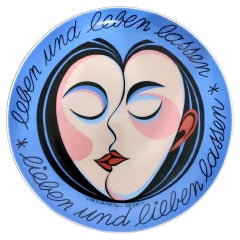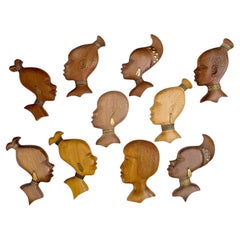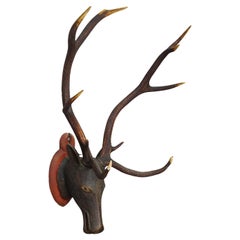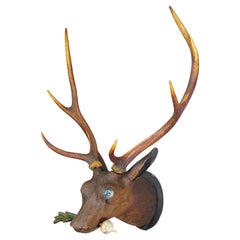DEKOLET Decorative Art
to
2
2
Height
to
Width
to
2
1
1
1
1
1
1
1
1
1
1
2
2
2
1
Victor Vasarely Rosenthal Studio Line Limited Edition Porcelain Plate
By Rosenthal
Located in Bochum, NRW
Victor Vasarely Rosenthal Studio Line, limited edition of 5000 pieces, no.: 4020, in unused, flawless condition.
Rosenthal artist plate No. 13 - "Live and let live - love and let lov...
Category
Vintage 1970s German Decorative Art
Materials
Porcelain
African Carved Wooden Women Heads in the Tribal Style.
Located in Bochum, NRW
Set of 10 African women's heads carved in wood in a tribal style. Great decorative effect in any decor.
Some of them with metal ornaments in their hair or around their necks.
Earring...
Category
Mid-20th Century African Tribal Decorative Art
Materials
Metal
Related Items
Antique Wooden Carved Black Forest Baroque Stag Head with 12 Point Trophy
Located in Berghuelen, DE
Antique Wooden Carved Black Forest Baroque Stag Head with 12 Point Trophy
A large antique Black Forest Baroque stag head. Carved in typical abstract style of the early 18th century....
Category
Antique Early 18th Century German Baroque Decorative Art
Materials
Antler, Wood
$2,325
H 39.38 in W 25.6 in D 16.15 in
Large Antique Wooden Carved Black Forest Baroque Stag Head with 10 Point Trophy
Located in Berghuelen, DE
Large Antique Wooden Carved Black Forest Baroque Stag Head with 10 Point Trophy
A large antique baroque stag's head. Carved in the typical style of the late 18th century. It has gla...
Category
Antique Late 18th Century German Baroque Decorative Art
Materials
Antler, Glass, Wood
$2,425
H 29.14 in W 23.23 in D 15.75 in
Rosenthal Studio Line Porcelain Plate by Björn Wiinblad 'Limited Edition'
By Bjorn Wiinblad, Rosenthal
Located in Waddinxveen, ZH
Stunning wall plaque by Bjorn
Wiinblad for Rosenthal. The plaque was produced in 1975 in an edition of 5000, and this one is number 1328.
The text on the plate is German ‘auch die...
Category
Vintage 1970s German Mid-Century Modern Shelves and Wall Cabinets
Materials
Porcelain
7 Hand Painted & Signed by Wiinblad Porcelain Christmas Plates, Rosenthal, 1970s
By Rosenthal, Bjørn Wiinblad
Located in Andernach, DE
Bjorn Wiinblad, Danish artist, has created this beautiful series for German art glass & porcelain makers Rosenthal for their Studio-Line art edition.
Plates from 1975 with the Annunc...
Category
Late 20th Century German Mid-Century Modern Decorative Art
Materials
Porcelain
$826 Sale Price / set
25% Off
H 0.63 in Dm 11.23 in
9 Artist Plates Collection Limited Edition by Rosenthal, Cocteau, Dali, Pucci
By Emilio Pucci, (after) Salvador Dali, Rosenthal, Jean Cocteau, Bjorn Wiinblad
Located in Andernach, DE
Extraordinary collection of 9 Artists-Plates by Rosenthal, Germany.
Ranging from 1971 to the mid 1980s, this series from their artists ''Studio-Line'' features designs from artist ra...
Category
Mid-20th Century German Mid-Century Modern Decorative Art
Materials
Porcelain
$2,536 / set
H 1.26 in Dm 10.24 in
African Vintage Shield, Tribal Wall Art, SONGYE SHIELD, Congo, Mid 20th Century
Located in Odense, DK
The Songye Shield is a striking example of African tribal art from the Congo, dating back to the mid-20th century. This shield, traditionally used by the Songye people for protection...
Category
Antique Late 19th Century Congolese Primitive Decorative Art
Materials
Wood
$2,450
H 62.21 in W 15.75 in D 0.79 in
English Carved Wooden Architectural Fragment
Located in Buchanan, MI
An English carved wooden architectural fragment in the manner of Adams,
pierced with scrolling foliage. This is a great piece for an overdoor p...
Category
Antique Late 18th Century English Adam Style Decorative Art
Materials
Wood
Artist Plate No. 7 by Bjørn Wiinblad for Rosenthal, Mid-Century, 1970s Germany
By Bjørn Wiinblad, Rosenthal
Located in Andernach, DE
''Auch die Schatten kommen von der Sonne'' (''Also the shadows are made by the sun'') –
is the No. 7 of the ''Artists-Plates'' from the Studio-Line by Rosenthal.
With a limited edi...
Category
Mid-20th Century German Mid-Century Modern Decorative Art
Materials
Porcelain
$291
H 1.26 in Dm 10.24 in
Antique Carved Folk Art Wooden Wall Hanging Commemorating The Royal Mail
Located in Hamilton, Ontario
This large antique folk art hand carved wall hanging is unsigned but presumed to have been made in England in circa 1880 in the Victorian style. The wall sculpture commemorates the Royal Mail stagecoach which was used for long distance mail delivery in the mid-1800s. The carving is very intricately executed and depicts the Royal Mail coach...
Category
Antique Late 19th Century English Folk Art Sculptures and Carvings
Materials
Wood
$1,195
H 18.5 in W 26 in D 1 in
Islamic Calligraphy Carved Wooden Plaque in the Form of a Falcon
Located in London, GB
Indian wood panel depicts Arabic calligraphy, Muslim prayer praising God, prophet Mohammed and Imam Ali, shaped in the form of a falcon, late 19th ce...
Category
Antique Late 19th Century Indian Decorative Art
Materials
Wood
$6,197
H 50.01 in W 36.23 in D 2.76 in
Christmas Glass Wall Plate Bjørn Wiinblad 1977 of Limited Edition, for Rosenthal
By Bjørn Wiinblad, Rosenthal
Located in Andernach, DE
Bjorn Wiinblad, Danish artist, has created this beautiful series for German art glass & porcelain makers Rosenthal for their Studio-Line art edition.
The Christmas decoration has bee...
Category
Mid-20th Century German Mid-Century Modern Decorative Art
Materials
Crystal
$204 Sale Price
40% Off
H 0.6 in W 11.42 in D 11.42 in
1970s VASARELY "Live and let live love and let love" Rosenthal Framed Plate
By Victor Vasarely, Rosenthal
Located in North Hollywood, CA
1970s VICTOR VASARELY "Live and let live love and let love".
Rosenthal collectible framed German plate.
Victor Vasarely Rosenthal Studio Line Limited Edition Porcelain Plate.
By Vasarely born 1936.
"Leben und Leben lassen, Lieben und Lieben lassen"
"Live and let live - love and let love".
Limited edition, signed and numbered.
Plate is in good condition, size is 12".
Frame is not in good condition, white became yellowish shows wear.
Victor Vasarely, born as Győző Vásárhelyi on April 9, 1906, in Pécs, Hungary, was a Hungarian-French artist widely regarded as the "father of Op Art" (Optical Art). He is known for his pioneering work in geometric abstraction and the use of optical illusions to create visually captivating and dynamic artworks.
Vasarely's early career involved studying medicine in Budapest, but he later decided to pursue his passion for art and enrolled in the Műhely (Workshop) academy in Hungary. He initially experimented with various styles, including Impressionism and Post-Impressionism, but his interest in geometric abstraction grew stronger over time.
In the 1930s, Vasarely moved to Paris, where he continued to explore geometric patterns, lines, and shapes in his art. He believed that art should not merely imitate nature but should create its own language of forms and colors to engage the viewer's perception actively. This philosophy led to the development of Op Art, a movement that emerged in the 1960s and focused on creating optical illusions and visual effects through precise geometric patterns and colors.
Vasarely's artworks often featured meticulously arranged geometric shapes, giving the impression of movement and three-dimensionality. He employed various optical tricks, such as the juxtaposition of contrasting colors and the use of repetition, to create an illusion of depth and visual dynamism. His artworks can evoke a sense of visual vibration and often challenge the viewer's perception.
Throughout his career, Vasarely's influence extended beyond the art world. He believed in the democratization of art and wanted to make art accessible to a wider audience. He embraced mass production techniques, creating what he called "multiple originals" or "serigraphs" (a form of screen printing). These serigraphs allowed him to produce multiple copies of his artworks at affordable prices, making them more accessible to art enthusiasts.
Vasarely's artistic legacy continues to be celebrated around the world. His work has been exhibited in numerous galleries and museums, and he remains an influential figure in the fields of Op Art and abstract geometric art. He passed away on March 15, 1997, in Paris, leaving behind a vast body of work that continues to captivate audiences and inspire artists to this day.
About Rosenthal:
German porcelain manufactory Rosenthal was originally founded as a ceramics-painting studio by Philipp Rosenthal Sr. (1855-1937) in 1879 at Schloss Erkersreuth in Bavaria, near the Czech border. Its first highly popular product was an ashtray inscribed with the words “Resting place for lit cigars.” In 1890, the company moved to the neighboring hamlet of Selb and, a year later, began to manufacture its own porcelain, since white porcelain was, at that time, in short supply. Rosenthal’s first complete table service was called Empire; it was exhibited along with other lines at Paris’s Exposition Universelle in 1900.
With the dawn of the 20th century, Rosenthal began producing porcelain tableware and services formed and decorated in the latest styles, like the Jugendstil Botticelli (1903), the Art Nouveau Darmstadt (1905), and the all-white Maria (1916) lines. Successes with this au courant approach led the company to launch an art pottery division in 1910, dedicated to luxury tableware, vases, and other decorative objects. By the 1930s, figurines were another important Rosenthal product, most notably the Disney-licensed Mickey Mouse pieces introduced in 1931.
In 1934, Philipp Rosenthal was forced to leave his company and country when his Jewish ancestry came under persecution by the Nazi regime. Despite the loss of its founder, the Rosenthal company remained the premier supplier of high-quality porcelain tableware to the Third Reich. After the war, in 1950, Philip Rosenthal Jr. (1916-2001) joined his father's company as an advertising manager. By 1958, he had become its CEO, continuing his father’s vision to produce high-quality porcelain in line with progressive tastes. Through the rest of the 20th century, Rosenthal was the most commercially successful porcelain producer in Germany.
In the postwar era, Rosenthal’s most famous tableware lines have included 2000 by Raymond Loewy and Richard Latham (1954), Magic Flute by Bjørn Wiinblad (1959), Suomi by Timo Sarpaneva (1976), and Moon by Jasper Morrison (1997). The company has enjoyed many popular and critically acclaimed collaborations with designers and brands, like Salvador Dalì, Tapio Wirkkala, Walter Gropius, Andy Warhol, Ron Arad, Enzo Mari, Konstantin Grcic, and Versace.
Rosenthal's product lines have encompassed more than ceramics over the years. In 1972, the company began producing furniture, under the subsidiary Rosenthal Einrichtung, in Espelkamp, Germany. Standouts from this arm of Rosenthal include Gunter Ferdinand Ris and Herbert Selldorf’s futuristic Sunball Lounge Chair (1969), Verner Panton’s Relaxer Rocking Chair (1974), Burchard Vogtherr's Vario Pillo...
Category
Late 20th Century German Post-Modern Decorative Art
Materials
Porcelain
$349
H 15.5 in W 15.5 in D 2 in



